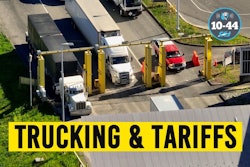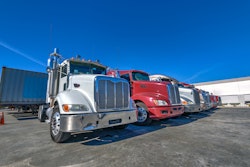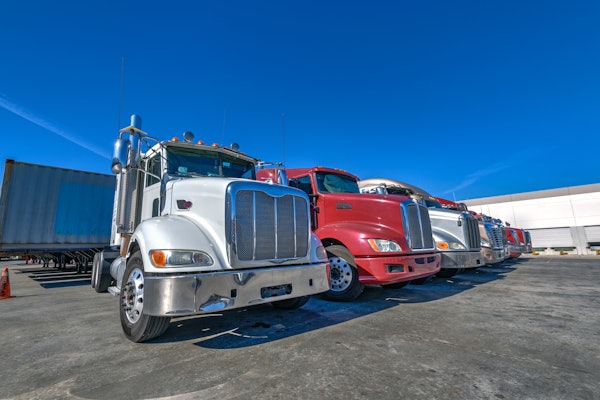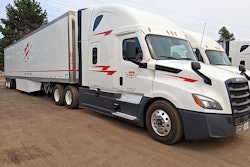During a webinar hosted Thursday by CCJ and sponsored by Valvoline, analysts Jason Miller, interim chairperson and professor of supply chain management at the Eli Broad College of Business at Michigan State University, and MIT Center for Transportation & Logistics Executive Director Chris Caplice offered insights on economic data and its impact on the state of the trucking market.
President Donald Trump’s proposed tariffs continue to fuel market uncertainty. Most recently, Trump announced 25% tariffs on imported steel and aluminum, proposed to take effect in March. The tariffs are a repeat policy that Trump initiated during his first term in office.
Although domestic production may see a slight increase, the overall demand for freight is expected to decline, Miller said. Higher costs for industries that rely on steel and aluminum would ultimately be passed on to consumers, dampening demand.
Miller highlighted research that the 2018-2019 tariffs on aluminum and steel showed a net loss on jobs. While employment in the aluminum and steel sectors saw modest gains, the broader impact on downstream industries led to greater overall job losses.
“As all of you remember, 2019 was a weak year for freight, so we’ve already experienced some of these consequences before,” Miller said.
Similarly, Miller said potential tariffs with Mexico and Canada could lead to consumers taking on the higher prices, particularly in the auto and agriculture sector, and postpone capital investment.
“The challenge right now is even without the tariffs implemented, the uncertainty the tariffs are creating are assuredly postponing capital investment,” Miller said. “We need a resolution. … We can’t be waiting every month for the President to say, ‘Well, okay, I’m happy for March, but if in April, it could kick in… we can’t have this for 48 months.”
Uncertainty caused by the threat of a potential tariff could also impact OEMs and consumer decision-making based on its implementation, with American Trucking Association estimating that tariffs in Mexico and Canada could add an estimated $35,000 cost to a Class 8 tractor.
Caplice noted the need for consistency with the administration’s policies. “People are still waiting. … If you want to improve things, you have to increase the certainty because then people can make investment.”
“We’re kind of in this transition or limbo period,” said Miller, pointing to how factors such as tariffs, as well as whether deregulation changes and possible business tax cuts, could dampen freight volumes.
A stable market?
As for the trucking market, supply and demand remains balanced, without sharp demand surges seen in past cycles, the analysts noted.
Caplice said the market has been declining since its peak in 2022, with a noticeable drop starting around April 2023. While there was some recovery, the market lost momentum at the end of January. The market has been slowly tightening over the past two years, Caplice observed, with the trend expected to continue with some fluctuations.
Unlike the rapid spikes seen during the pandemic, Caplice predicts a “slow boiling of the water” and doesn’t expect a sudden surge in demand or major disruption in trucking capacity. Rather, Caplice believed the market will gradually adjust throughout the first half of 2025.
Miller agreed, adding the next market cycle will be more like 2013-2014 and that it won’t resemble the extreme market shifts from 2020 to 2021. He added that even the strong growth of 2017-2018, wherein the industry was fueled by business tax cuts, a fracking boom, and global manufacturing expansion, isn’t likely to repeat.
Miller said the only tailwind is the expectation of interest rate cuts, which the Fed has already said are unlikely near-term, and factors like low commodity prices, slowing warehouse construction, and high mortgage rates might indicate there won’t be a surge of demand.
So, with a stable market, why does recovery seem slow and shows little sign of acceleration?
Historically, Miller said it takes a big surge in demand shake things up. Until that happens, the truckload sector will remain likely steady. Meanwhile, LTL sector can continue raising rates in a more controlled way.
Caplice added that looking at past cycles, a spike in demand will create capacity issues that will push rates higher. “The capacity restriction adds to that fire,” he said.
The last cycle took so long, Caplice said, as demand climbed so high, that it took a long time for capacity to leave the market.
The best- and worst-case scenario
Talking about spot and contract rates, Caplice explained that rates have been rising for the past 18 months, but they started from a very low base, so the market is still in recovery. He expects rates to keep increasing through the first half of the year, though not suddenly.
Freight rates have grown at a steady pace of 2.3% to 2.7% per year since 2012, Caplice said, and he believes that trend will continue. While there may be small fluctuations quarterly, both spot and contract have been in inflationary trend for some time.
Miller said if concern over tariffs dials down, he expects spot rates to rise about 10% this year, with more noticeable increases later this year. However, this depends on demand returning. “We need some degree of certainty for that to happen.”
The best-case scenario, Miller said, is if tariffs aren’t a major issue and businesses feel more confident investing, there should be some “robust rate growth” of about 10% to 15% year-over-year, with the biggest gains in the second half of the year.
The worst-case scenario, he said, is if the U.S. imposes heavy tariffs on key trade partners like Canada, Mexico, the EU, Japan, South Korea, Taiwan, and China – without a business tax cut to offset the impact – freight volumes could decline upwards of 2% by the end of the year, pushing 1% to 2% of trucking capacity out of the market and leading to flat or slightly lower rates.
EV infrastructure
The analysts also touched on the Trump administration’s policies on sustainability and electric vehicles, with Caplice emphasizing, “You’ve got to let the market decide and the innovation to happen rather than dictating a solution right away.”
“Whenever you dictate a solution, you stifle innovation,” he said, pointing out the North American Council for Freight Efficiency and its “messy middle” term of exploring different options with the right infrastructure.
Caplice also pointed out the EV adoption already happening in Class 3-5 vehicles, though Miller added that electric trucking remains a “short-distance game”.
"Let things play out a little bit, probably for the equipment makers,” Miller said. Without clear long-term policies, Miller said it may be worthwhile for companies to hold off on major investments. “Uncertainty is the name of the game right now in a lot of these areas.”














